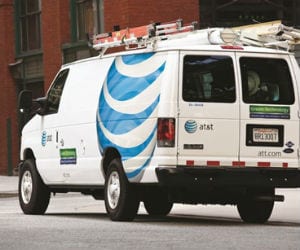 Imagine a fleet that runs on domestically produced fuel that costs less than $2 per gallon. Then imagine if that fleet could also have significantly lower maintenance and repair expenses over its lifetime.
Imagine a fleet that runs on domestically produced fuel that costs less than $2 per gallon. Then imagine if that fleet could also have significantly lower maintenance and repair expenses over its lifetime.
Too good to be true?
Perhaps, but the growing number of companies using natural gas vehicle (NGV) technology swear by it. In the past few years, AT&T, Verizon Wireless, and Waste Management have all made substantial investments in NGV fleets:
- AT&T has deployed over 5,500 NGVs since 2009 and expects that number to reach 8,000 by 2018.
- In late 2010, Verizon Wireless converted over 500 Ford E-250 cargo vans to operate on natural gas and has added dozens more since.
- Waste Management operates 1,400 natural gas-powered waste collection and service trucks nationwide, and says that NGVs will represent approximately 80 percent of the company’s new truck purchases for 2012 and over the next five years.
Yet, it’s not just the big boys with multibillion-dollar fleet budgets jumping into the NGV fray. Smaller firms, like Frecka Plumbing Company, based in Cuyahoga Falls, Ohio, are also investing in vehicular natural gas. The company recently converted 10 of its Chevrolet Express service vans to run on compressed natural gas (CNG).
Asked why Frecka made the switch from traditional gasoline to CNG, Tim Frecka, the company’s vice president, told WKYC: “We haven’t been able to raise our company’s rates because of the economy. So any way we can save money on our end is great.”
Where Do the Savings Come From?
According to the latest fuel price report (which is updated quarterly) produced by the U.S. Department of Energy, the price difference is approximately $1.80 per gallon in favor of CNG.
Some people may wonder whether compressed natural gas works the same as gasoline — whether the fuel-efficiency rates are the same. Are we really comparing apples to apples?
“Yes,” says Stephe Yborra, the director of market development for NGVAmerica, a national trade association for the vehicular natural gas industry. “Today’s natural gas spark-ignited engines deliver the same fuel and engine efficiency as their gasoline counterparts. So, on a miles-per-gallon basis, the only slight difference that might be there is that the CNG fuel system adds somewhere between 300-400 pounds of weight. We’re talking about a very minor differential.”
Natural gas conversions aren’t cheap, though, ranging from $10,000 to $15,000, depending on the vehicle make, model, type of fuel system (dedicated CNG or bi-fuel) and the number of fuel tanks installed, among other factors.
But NGVs are also getting a lot more popular. In the last few years, NGV options for field service operations have grown considerably, including these vehicles, often used in field service operations:
- GM’s Chevrolet Express/ GMC Savana cargo vans; Chevrolet Silverado/ GMC Sierra 2500 and 3500 H-D pickups.
- Ford E-Series full-size work vans; Transit Connect vans; F-Series pickups.
- Chrysler’s Ram 2500 Heavy Duty pickups.
Do the Fuel Savings Justify the Investment Costs?
The answer lies in fuel consumption: “The more fuel you use, the more money you save, therefore the faster the payback and the overall lifecycle savings,” Yborra says. “If I save $2 per gallon but I’m only using 1,250 gallons of fuel per year, that’s $2,500 per year in savings. OK, so that gives me a payback, but that takes a little bit longer than I may want. But if I’m using 2,200 gallons of fuel per year, that’s $4,400 per year — that’s a much shorter payback period.”
Say it costs $12,000 to equip a van for CNG use, and your annual fuel savings is $4,400. The payback would take less than three years. On paper, this translates into $4,400 back to your bottom line each year for each CNG-equipped vehicle, beginning after its third year in operation.
Where to Fill Up?
But before going “all-in” on NGVs, make sure natural gas fueling stations are near your operations. “Proximity to public fueling is certainly preferred. We’re not glossing over the fact that we have to build more fueling infrastructure,” Yborra says. “But the difference in fuel cost [between CNG and gasoline] is driving an increase in demand, so there’s a tremendous amount of [market] interest in expanding the fuel supply.”
Here’s an up-to-date listing of public natural gas fueling stations.
Some companies, like Frecka Plumbing (mentioned above), are even installing their own CNG fueling stationsonsite to ensure sufficient fuel supply.
The Bottom Line
Do your vans burn enough fuel per year to generate payback on NGVs within a reasonable time period? If so, is there sufficient CNG fueling infrastructure available near your operations? Put pencil to paper to explore whether natural gas vehicles make economic sense for your fleet operations.
Related: AT&T Making Serious Bid to Green Up Its Fleet.
Click here to download a free whitepaper, “Five Steps to Make Field Service Profitable.”

Share this: